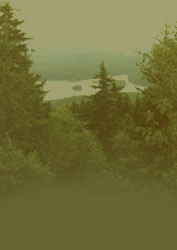|
Do you have something
happening in your corner of Washington? - Please call a member
or e-mail your observations to have them included here
December:
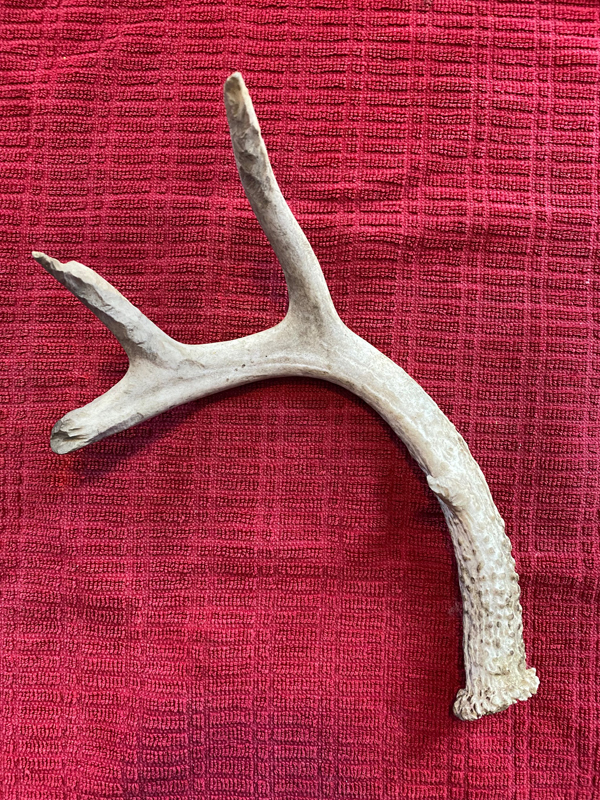
Antler Photo by Nan Schwartz, note the chewing on the antler tips!
Deer and moose shed their antlers every year, so why don’t we find more of them scattered around in the woods when we’re out for a walk? Turns out we’re not the only ones looking for them. We might think of antlers mostly as a way to identify a male deer or moose, but antlers are an important part of the entire forest ecosystem.
Antlers are not horns. Antlers grow from the tip while horns grow from the base. Healthy antlers are a sign of a healthy animal. Males in the deer family, cervidae, include moose, deer and elk, and they grow new antlers every summer. The size of the antlers can tell you more than just the age of a white-tail buck or a bull moose. It’s an indication of fitness, good nutrition and good genetics. But the capacity for larger antlers does increase with body mass.
Their primary function is reproduction, as advertisement to the females. But they also serve as formidable weapons for territorial dominance in contests with rival males during the rut, their fall breeding season.
After the breeding season, antlers have served their purpose. They’re heavy and get in the way as the males walk through the woods. They are now more intent on eating enough to rebuild their strength to survive the winter. In New Hampshire this typically happens in January, although it can vary. But that’s NOT the end of the story!
Antlers contain calcium which is vital for teeth and bones and supports nerve function, muscle contraction, and vision. Phosphorus helps produce protein for growth and organ function.
Rodents like mice, chipmunks, and squirrels, as well as porcupines and raccoons, gnaw on shed antlers. The antlers often show teeth marks, evidence of nature’s elegant system of nutrient recycling. There are wildlife camera images documenting rabbits, opossums, coyotes and even deer chewing on antlers.
And that is why shed antlers are not so easy to find.
This information and more found at SPNHF and is a portion of a "Something Wild" broadcast , which is a collaboration of the Forest Society and NH Audubon and NHPR
November:
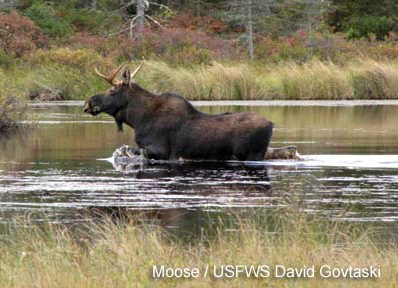
Moose Photo by David Govtaski USFWS
Where do moose go in the summer to deal with the summer heat?
Moose is an Algonquin term for "eater of twigs." Moose are primarily browsers feeding on leaves, twigs, and buds of hardwood and softwood trees and shrubs. Their diet consists of both aquatic and land based plants. Therefore, an ideal habitat for a moose will consist of a young dense forest, with access to ponds, lakes, bogs or wetlands that moose would be able to wade in. This not only provides a food source for the moose, but also shelter from predators and the summer heat. The summer heat forces the moose to either cool off by laying down in the shade of a thick forest, or go swimming.
A healthy moose will eat 40-60 pounds of browse daily. Moose favor willows, birches, aspens, maples, fir, and viburnums, in the fall they begin feeding on the bark of some hardwoods, particularly maples and aspens. In the winter moose feed on the buds and new woody growth of these plants.
In summer moose feed heavily on sodium-rich aquatic plants. While sodium is available in woody plant diet of leaves, twigs, and buds, the emergent or submerged aquatic plants produce an average of four times more nutrition than terrestrial plants. Aquatic plants are more digestible and have higher concentrations of minerals than woody forest browse of the more typical winter moose diet. In summer, both male and female moose seek shallow aquatic habitat provided by wetlands and shallow ponds and edges of larger lakes to forage on super-nutritious aquatic vegetation. Beaver ponds are a particularly important landscape feature, providing sunny, open expanses of shallow water with mucky bottoms favored by these aquatic plants in an otherwise heavily forested landscape.
Cows also prefer to keep their calves near water as an escape route for their calves. Ponds are used by both sexes to escape from moose flies and other pesky insects and to keep cool. Moose licks form in wet areas on the sides of highways where road salt accumulates. Moose visit these areas to drink the salty water thereby satisfying their salt requirements.
You may be lucky enough to see a moose in the summertime if you look for those quiet, wet areas with abundant aquatic plants that they like to eat.
This information and more found at NH Fish and Game,
SPNHF and
NH State Parks
October:
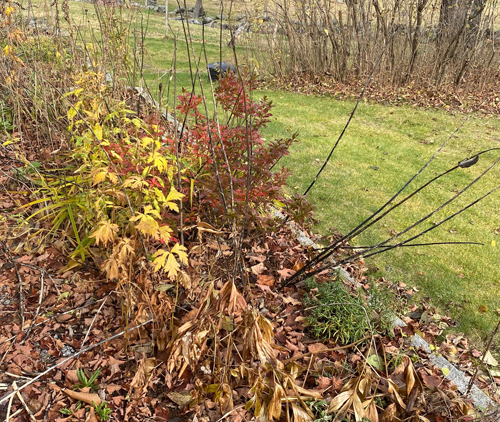
Garden Photo by Nan Schwartz
October is often the month that we say goodbye to the garden and “put it to bed.” Many gardeners like to perform a garden clean-up at the end of the season before the onset of winter. Usually this means cutting back perennials, pulling up spent vegetables and annuals, and raking up leaves as they drop from the trees and shrubs. In addition, some annuals and tender bulbs can be dug up and brought indoors to use again next season, and marginally hardy perennials and evergreen shrubs can be protected to help them come through the winter without too much damage.
When you go to put your own garden to bed this fall, keep in mind the following tips.
Cutting back your perennials:
Leaving perennial seed heads provides natural foraging habitat for native wildlife. In the winter months when food is scarce, gardens full of withered fruit and dried seed heads can provide birds with a reliable food source. Seed-eating songbirds such as finches, sparrows, chickadees, juncos, and jays will make use of many common garden plants. When cleaning up the garden, prioritize removing and discarding diseased top growth, but leave healthy seed heads standing. Leaving perennial seed heads provides natural foraging habitat for native wildlife. In the winter months when food is scarce, gardens full of withered fruit and dried seed heads can provide birds with a reliable food source. Seed-eating songbirds such as finches, sparrows, chickadees, juncos, and jays will make use of many common garden plants. When cleaning up the garden, prioritize removing and discarding diseased top growth, but leave healthy seed heads standing.
Leaves:
1 Rake up and compost or discard the leaves. Composting leaves is a good way to recycle nutrients, and compost can be used to improve the soil.
2 Mulch the leaves in place with a lawn mower. This not only cuts down on labor, but also returns nitrogen to the soil as the chipped leaves decompose. Mulching leaves into the lawn works very well as long as it is done several times throughout the season. Once a thick layer of leaves builds up, it is nearly impossible to get all of the pieces to filter down between the grass blades. At that point, it is much easier to simply rake them up and add them to the compost.
3 Save the leaves to use as mulch. Leaves can make a wonderful mulch for annual, perennial, and vegetable gardens if they are chipped into small pieces. A thick layer of chipped leaves can be just as effective at suppressing weeds and conserving soil moisture as bark mulch, and they usually break down within a season and build soil organic matter.
Pull up Annuals and Vegetables:
After the first killing frost it’s time to remove annual flowers and vegetable plants from the garden. Not only is this debris unsightly, but if left in place it can potentially contribute to disease issues next year.
Two common fungal disease of tomato, early blight and Septoria leafspot, overwinter in the soil of crop debris. Pulling up and discarding all parts of infected plants helps reduce infection the following season, particularly in small gardens that do not have much opportunity for crop rotation.
If desired, some annual plants can be successfully saved from season to season by either digging them up or taking cuttings before frost. For instance, coleus can easily be saved from year to year by potting up entire plants and keeping them indoors over the winter, or by rooting cuttings. Other plants that can be kept with relative ease include geraniums, fuchsia, lantana, begonias, and impatiens.
Dig Up Tender Bulbs:
1 Use a garden fork or a spade to loosen the soil around the entire plant.
2 Gently lift the bulbs from the ground, being careful not to cut or skin them in the process. Any damage allows disease organisms to enter, leading to rot and storage losses.
3 Clean the soil from the bulbs. Swish them around in a tub of water or use a garden hose to wash away any clumps of soil before allowing them to dry and cure.
4 Place the bulbs in a well-ventilated area with a constant temperature between 60 and 70° and out of direct sunlight for a few days. Always remember to label all stored bulbs.
Once the bulbs have cured, they should be packed in moistened sphagnum peat, vermiculite, or wood shavings. A little moisture goes a long way. If the storage medium is too wet, the bulbs will likely rot. The bulbs can be placed inside plastic bags or cardboard boxes and then covered with peat or vermiculite.
Protect Vulnerable Trees and Shrubs
Some perennials and shrubs can benefit from a little extra winter protection. Butterfly bush (Buddleja davidii) and bluebeard (Caryopteris sp.) don’t always make it through the winter unless they are given a defense. Sometimes all it takes is adding an extra layer of mulch over the roots to insulate them from extreme cold. Periods of freezing and thawing can also heave new plantings from the ground, and in the process exposes the roots to drying winter winds. Mulching insulates the soil and prevents frost heaving. At least two inches of woodchips, shredded leaves, or straw should be applied over the root zone, taking care not to pile mulch against the plant’s trunks and crowns.
Wait to Prune
Although it may be tempting to pull out the pruning saw and loppers after the leaves have fallen, it is almost always best to wait to prune trees and shrubs until late winter or early spring. By waiting to prune until late dormant season (February to early April), gardeners avoid a number of physiological and disease issues. Pruning in the fall often causes dieback at the pruning sites, as new growth at wounds is more susceptible to damage from severe winter temperatures.
This information and more found at UNH Extension
September:
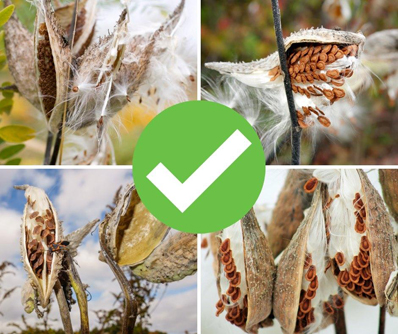
Milkweed seeds ready for collection, Photo by UNH
NH Fish & Game and UNH Cooperative Extension are calling on New Hampshire residents for milkweed pod collections!
The seeds from the milkweed pods will be sown by NH Department of Transportation into conservation corridors, designated areas along highways that are planted with native perennials to benefit pollinators.
While milkweed serves as a food source for many other species of pollinator, it is the exclusive host plant on which Monarch butterflies lay their eggs, and on which caterpillars feed. The disappearance of milkweed across the US has contributed to an 80% decline in the eastern Monarch butterfly population over the last 20 years. State and federal agencies, conservation organizations, and others are working diligently to increase the volume of milkweed on the landscape, and individuals can help by contributing to this important resource collection effort.
Collecting Milkweed Pods
• Only collect the pods when they are dry and grey/brown. If the center seam pops with gentle pressure, they can be harvested.
• Store the pods in paper bags; plastic bags will collect unwanted moisture.
• Write the date and county collected on the bag.
• Keep the pods in a cool, dry place until you deliver them to the collection site.
• Leave some pods (25%) on the plants to also allow for natural dispersal.
Collection bins can be found at the following locations throughout New Hampshire. The following are local to Washington. Unless noted otherwise, bins are located outside the front door to the building.
Concord - NH Fish & Game Headquarters, 11 Hazen Drive
Newport - UNH Extension Sullivan County Office, 24 Main Street
Information found at UNH
August:
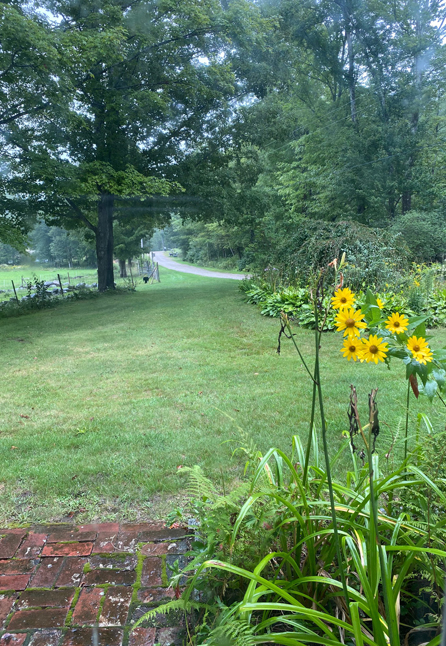
Rainy day photo by Nan Schwartz
After a stretch of dry weather that dragged on for months, New Hampshire just endured one of its rainiest months on record.
At the start of July, more than 90% of New Hampshire was experiencing abnormally dry conditions as part of a drought that has gripped most of the state for more than a year. While parts of northern New Hampshire are still facing a rain deficit, it’s a different story in the southern half of the state, which is a bit waterlogged after several periods of heavy rainfall that included a sizable dose of rain from Tropical Storm Elsa.
In Concord, where weather records date back to 1868, 13.04 inches of rain was measured, making it the rainiest July in recorded history. It’s also the second-rainiest month on record for the capital city, trailing only October 2005.
It was even rainier in western and southwestern New Hampshire, where the most recent rains led to multiple flash flooding bouts and road damage, like we saw here recently in Washington.
Information found at WMUR
June:
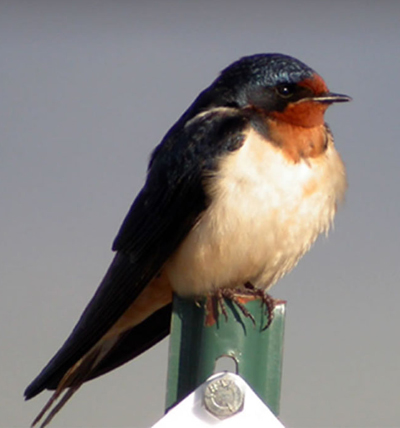
Photo byNational Parks Service
The Schwartz barn has been home to many Barn Swallow families through the years. They recently had a nest with 5 baby birds that kept the mother bird very busy feeding them.
Six species of swallows breed in New Hampshire; the Purple Martin, the Tree Swallow, the Northern Rough-Winged Swallow, the Bank Swallow, the Cliff Swallow and the Barn Swallow. They are aerial insectivores who catch insects on the wing.
The Barn Swallow can be identified by their long forked tail and uniformly glossy blue-black above with buffy-orange underparts.
They are found most frequently in agricultural areas and along rivers and lakeshores, but will also use smaller openings in forested or residential landscapes. They build a cup-shaped mud nest on a horizontal surface, often in barns or under bridges, but will also build nests on porches or under the eaves of houses. They historically nested on cliffs or rock crevices, and may occasionally do so in NH. They occur statewide except high elevations of the White Mountains.
Barn Swallows typically nest in colonies of 5-20 pairs, but they will also nest singly when nest sites are limited.
They arrive in NH in mid-April (11-20) from their winter home primarily in South America, with lesser numbers in Central America and southern Mexico.
Although increasing in the southern US, long-term declines in the north result in an overall decline across the breeding range. Along with the Chimney Swift, this is the aerial insectivore that is showing declines across the majority of its range in North America. As such it should be considered a conservation priority even though populations are still relatively high compared to other species of swallow. The NH population is declining at 5% per year. Unlike Bank and Cliff Swallows, Barn Swallows tend to occur singly or in small colonies, and while this makes it harder to track a significant portion of the population, anecdotal data suggest that most of New Hampshire’s larger colonies have declined significantly.
Because most of the swallow species are declining in New Hampshire NH Audubon is keeping track of the populations and collecting data through their “Swallow CORE” project.
Visit this website to learn more about participating and find information about all the NH swallow species:
New Hampshire Audubon
May:
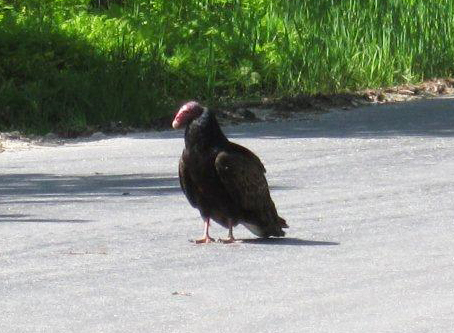
Photo by Arin Mills
Jed had a group of Turkey Vultures hanging out near his pasture, feasting on some dead animal for a few days. He had seen them earlier soaring high above in circles looking for their next meal.
The Turkey Vulture is the only species of vulture that breeds in New Hampshire and it has become a familiar sight over most of the state. They circle overhead looking for something to eat. They fly in a “V” shape and teeter from side to side.
Because they eat carrion (dead animals), vultures are often thought of a disgusting or unclean, but if there weren’t organisms out there to eat and breakdown everything that dies we would be neck deep in carcasses. Their diet is a little gross but we should appreciate how superbly adapted they are to this life of grime.
Like other birds of prey the Turkey Vulture is blessed with long, broad wings for efficient soaring, This allows them to cover large areas without expending much energy. They search for food through a combination of sight and a keen sense of smell, with one of the best senses of smell among birds. Once food is located Turkey Vultures are quick to capitalize on it. If the dead animal is small they may swallow it whole. With larger carcasses they look for soft tissue areas to start things off.
Once food is consumed the Turkey Vulture’s digestive system gets to work. Using powerful acids that breakdown most of what they eat, their digestive system effectively destroys toxic bacteria including rabies, anthrax, botulism, cholera and salmonella. if an adult Turkey Vulture is disturbed at its nest by a potential predator it will regurgitate (throw up) as a defense mechanism. Once the threat is over he will consume the regurgitation. This same delicious mix is fed to young vultures until they are old enough to eat larger pieces of meat.
Also, at the opposite end of the digestive tract, they produce a highly concentrated excretory product called uric acid and they use it in a unique way. When the bird is overheating it will direct its urine directly on to its legs and feet to help it cool while it is evaporating.
They can find easy meals on the sides of roads where road kill is abundant. If you have seen one of these birds it was probably on a roadside feasting on some poor animal that didn’t make the crossing without getting hit.
Information found at New Hampshire Fish & Wildlife
April:
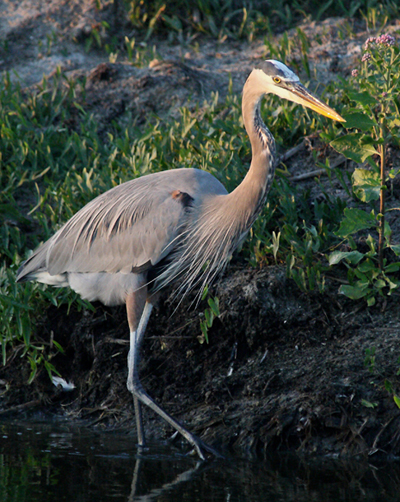
Photo by Robert Burton, US Fish and Wildlife
Reid and Cody saw a flock of six Great Blue Herons flying in a "V" formation! We had no idea that GBHs flocked together when flying and we decided that more information about them was needed!
The Great Blue Heron is the largest heron in North America. Often seen standing silently along inland rivers or lake shores, or flying high overhead with slow wingbeats, its head folded back with its neck into an “S” shape onto its shoulders, trailing its long legs behind.
They are partial migrants and fly by day or night, alone or in flocks. Some wander well to the north in late summer. They generally move away from the northern edge of their breeding range in winter, with some flying as far south as the Caribbean.
They breed in colonies, often of this species alone, but sometimes mixed with other wading birds; rarely in isolated pairs.
The male chooses a nest site and displays there to attract mate. Displays include stretching neck up with bill pointing skyward, flying in circles above colony with neck extended, stretching neck forward with head and neck feathers erected and then snapping bill shut. The nest site can be highly variable, usually in trees 20-60' above ground or water; sometimes in low shrubs, sometimes on ground (on predator-free islands), sometimes well above 100' in tree. The nest (built mostly by female, with material gathered mostly by male) is a platform of sticks, sometimes quite large. Both parents feed the young, by regurgitation. The young are capable of flight at about 60 days and depart the nest at about 65-90 days. They have 1 brood per year in the north and sometimes 2 in the south.
They forage, usually alone, mostly by standing still or walking very slowly in shallow water, waiting for fish to swim near, then strike with rapid thrust of bill. They also forage on shore, from floating objects, and in grassland and hunt by day or night. They are highly variable and adaptable. They eat mostly fish, but also frogs, salamanders, turtles, snakes, insects, rodents, birds. They have been seen stalking voles and gophers in fields, capturing rails at edge of marsh, eating many species of small waterbirds. With its variable diet it is able to spend the winter farther north than most herons, even in areas where most waters freeze.
The birds they saw flying in a "V" were most likely going off together to their breeding colony for their spring rituals. We will see them again, alone, fishing on the egde of a pond or wetland later in the spring.
Information found at Audubon.com
February:
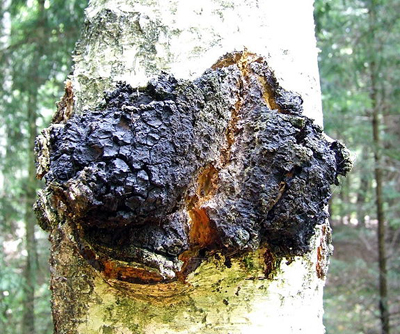
Photo by Tomas Cekanavicius
Arin harvested some chaga from a birch tree and has been making a tea with it. What is chaga, you may wonder. The chaga mushroom is a slow growing, non-toxic fungus that grows primarily on birch trees in cold climates. With an appearance similar to burnt charcoal, it has been harvested for centuries as a traditional medicine. Chaga produces a woody growth, or conk, which looks similar to a clump of burnt charcoal — roughly 10–15 inches in size on the host tree. However, the inside reveals a soft core with an orange color.
For centuries, people have used chaga mushrooms for medicinal purposes. Packed with antioxidants, chaga mushroom is available in tea or supplement form. Though research is ongoing, some scientific studies indicate that chaga extract may provide certain health benefits. Animal and test-tube studies found that chaga extract may boost immunity, prevent chronic inflammation, fight cancer, lower blood sugar levels and reduce cholesterol. However, more human studies are needed.
No studies have analyzed the safety or appropriate dosage of chaga. Unwanted side effects could occur if you have a bleeding disorder or autoimmune disease, take blood thinners or are pregnant or breastfeeding. If you’re interested in trying chaga mushroom tea or supplement but have concerns about side effects or possible interactions with medications your taking, talk to your doctor first.
Information written by Mary Jane Brown, PhD, RD (UK) and found at Healthline.com
January:
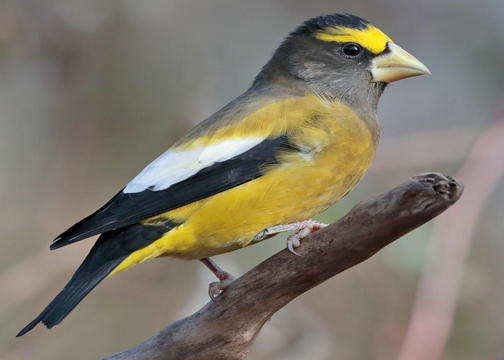
Photo byCeline Bellemare
Arin was lucky and saw a flock of Evening Grosbeaks recently. They are becoming more and more uncommon.
A heavyset finch of northern coniferous forests, the Evening Grosbeak adds a splash of color to winter bird feeders every few years, when large flocks depart their northern breeding grounds en masse to seek food to the south. The yellow-bodied, dusky-headed male has an imposing air thanks to his massive bill and fierce eyebrow stripe. The female is more subtly marked, with golden highlights on her soft gray plumage. This declining species is becoming uncommon, particularly in the eastern United States.
Although they may not visit your backyard every year, Evening Grosbeaks show up irregularly at feeders during the winter. They eat sunflower seeds and are also attracted to the seeds, berries, and buds of trees and shrubs—especially maples. They are fairly large birds and they often travel in sizeable flocks, so they often use platform feeders as opposed to tube feeders.
With their enormous bills, Evening Grosbeaks can crush seeds that are too large for Common Redpolls and Pine Siskins to open. These smaller birds often seek out the grosbeaks and glean the food scraps they leave behind.
Information and plan found at Cornell University - All About Birds
To view yearly archives of our "New In
Nature" series click on year you wish to see.
2002
2003
2004
2005
2006
2007
2008
2009
2010
2011
2012
2013
2014
2015
2016
2017
2018
2019
2020
|


